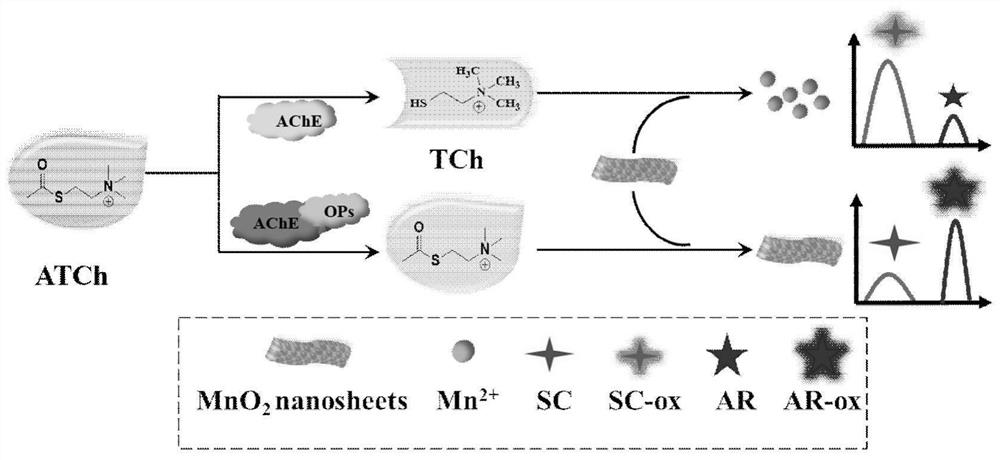Detection of organophosphorus pesticides by ratiometric fluorescent sensor based on manganese dioxide nanosheets
A technology of organophosphorus pesticides and fluorescent sensors, which is applied in the direction of fluorescence/phosphorescence, instruments, measuring devices, etc., can solve the problems of single response signal interference, etc., and achieve the effect of low raw material cost, short experiment cycle and simple principle
- Summary
- Abstract
- Description
- Claims
- Application Information
AI Technical Summary
Problems solved by technology
Method used
Image
Examples
Embodiment 1
[0034] Embodiment 1: Manganese dioxide nanosheet (MnO 2 NS) synthesis
[0035] 10mL of 3wt% hydrogen peroxide was mixed with 10mL of 1.2M tetramethylammonium hydroxide solution and quickly added 10mL of 0.3M MnCl within 15 seconds 2 solution, the solution immediately turned dark brown, and then the suspension was vigorously stirred at room temperature for 12 h, and the resulting solution was centrifuged in a centrifuge for 20 minutes (2000 rpm), then washed three times with water and methanol, and dried at 60 ° C. Dry in an oven to obtain massive manganese dioxide. Weigh 10mg block manganese dioxide and dissolve it in 10mL ultrapure water and sonicate for 12h to completely disperse the manganese dioxide. The dispersion is centrifuged in a centrifuge for 30 minutes (2000rpm), and the supernatant is reserved for the next experiment.
[0036] image 3 A shows the synthesized MnO 2 TEM images of NS, from image 3 It can be seen in A that it has a two-dimensional sheet structu...
Embodiment 2
[0037] Example 2 Manganese dioxide nanosheets (MnO 2 NS) synthesis
[0038] 10mL of 2wt% hydrogen peroxide was mixed with 10mL of 1.1M tetramethylammonium hydroxide solution and quickly added 10mL of 0.2M MnCl within 30 seconds 2 solution, the solution immediately turned dark brown, and then the suspension was vigorously stirred at room temperature for 12 h, and the resulting solution was centrifuged in a centrifuge for 20 minutes (2000 rpm), then washed three times with water and methanol, and dried at 60 ° C. Dry in an oven to obtain massive manganese dioxide. Weigh 10mg block manganese dioxide and dissolve it in 10mL ultrapure water and sonicate for 12h to completely disperse the manganese dioxide. The dispersion is centrifuged in a centrifuge for 30 minutes (2000rpm), and the supernatant is reserved for the next experiment.
Embodiment 3
[0039] Example 3 Acetylcholinesterase induces MnO 2 Nanosheets (MnO 2 NS) decomposition and fluorescence changes of SC and AR
[0040] 0.5 U / mL AChE (50 μL) and 5 mM ATCh (20 μL) were mixed with 30 μL PBS buffer. After incubating at 37°C for 30 minutes, 30 μL of the MnO prepared in Example 1 was added 2 Nanosheet solution (0.5 mg / mL) and 54 μL PB buffer. The resulting mixture was incubated at room temperature for 30 minutes. Next, add 6 µL of SC (50 µM) and 10 µL of AR (50 µM) to the above mixture and make sure the final volume is 200 µL. Fluorescence spectra of different samples were recorded under excitation at 380 nm and 560 nm, respectively, at room temperature. figure 2 A is the fluorescence spectrum of SC and figure 2 B is the fluorescence spectrum of AR,
[0041] ATCh / MnO2 NS / SC / AR (a), ATCh / AChE / MnO2 NS / SC / AR (c).
[0042] 0.5 U / mL AChE (50 μL) and 5 mM ATCh (20 μL) were mixed with 30 μL PBS buffer. After incubating at 37°C for 30 minutes, 30 μL of the MnO p...
PUM
| Property | Measurement | Unit |
|---|---|---|
| concentration | aaaaa | aaaaa |
Abstract
Description
Claims
Application Information
 Login to View More
Login to View More - R&D
- Intellectual Property
- Life Sciences
- Materials
- Tech Scout
- Unparalleled Data Quality
- Higher Quality Content
- 60% Fewer Hallucinations
Browse by: Latest US Patents, China's latest patents, Technical Efficacy Thesaurus, Application Domain, Technology Topic, Popular Technical Reports.
© 2025 PatSnap. All rights reserved.Legal|Privacy policy|Modern Slavery Act Transparency Statement|Sitemap|About US| Contact US: help@patsnap.com



